A Challenge for the new age
Modernisation, communications and innovation are now a reality and an integrated
part of our everyday life at the office of the FCI. In response to the many solicitations
that reach us daily from every part of the globe, we supply information and try
to provide the best possible services to our member countries and to the world of
organised dog-related activities.
In fact we continuously strive for excellence.
Suddenly the world has gone global in many respects and all of us feel the need
to be in full and immediate contact at all moments. Consequently, the need to communicate
within the major areas of our activities has increased and so have the demands for
immediate responses. For this reason also, the requests that are forwarded to our
Organisation at management level have increased tremendously and almost instantly.
Read more
Carla Molinari
Treasurer of the FCI
Most common dental problems in puppies
Introduction
At the age of seven to eight months latest a puppy should have a full set of a total
of 42 permanent teeth. Since not all changes in dentition go smoothly, this should
be checked out by a veterinarian at the age of 4 to 6 months to make sure that there
are no problems. Every trauma to baby teeth like luxation or fracture needs to be
professionally addressed immediately, since severe damage to the permanent tooth
buds is a very frequent result.
Persistent baby teeth
A common problem, particularly in small breeds, is a failure of puppy teeth to fall
out, especially the canines. Now we have two teeth occupying a space that was designed
for just one tooth. This can lead to serious and painful dental malocclusions (improper
bites) such as the lower canine teeth biting into the palate of the mouth. If the
permanent tooth has broken through the gum and the baby tooth is still in place,
the baby tooth should be extracted immediately. This will then allow the permanent
tooth to grow into the right location and position.
Ectopic teeth / tooth malformation
Teeth sometimes do not develop in the correct axial position or in the wrong place.
If they cannot be moved back orthodontically into the right position, extraction
is recommended. Teeth that come out with irregular shape, size and structure are
mainly caused by a trauma to the tooth buds. They are often retained and extraction
is indicated in most cases.
Retained teeth
These teeth are lying in the jawbone, more or less in their correct position but
don’t come through to the surface. If presented at an early stage (5-7 months) the
eruption process may be re-induced through surgery. If the case is presented too
late then surgical extraction is the recommended treatment, since they can cause
cysts. If they are not extracted, x-ray control is needed (1x/year) to monitor their
progress.
© courtesy Dr. Dr. Fahrenkrug


A retained baby canine tooth in a dog. Tooth is fractured and infected, note the cyst which has developed
Supernumerary teeth
This refers to the presence of more than 42 permanent teeth after the shedding of
all baby teeth in puppies. In dogs this is mainly seen with the incisors (8 instead
of 6), where treatment is often not required. In principal, every tooth can develop
as a twin tooth, including double canine teeth. As a general rule those teeth which
fit better with the opposite teeth should be kept and the others extracted.
Summary
The development of the baby and permanent teeth are highly complicated biological
processes and should be monitored closely by a vet. If there is a constant discomfort
and dental pain, the puppy may not let anyone handle its mouth and head anymore
which can lead to undesired behaviour problems. Early treatment is the best choice
to prevent permanent dental and behavioural problems.


Dr.med.dent. Dr.med.vet. Peter Fahrenkrug
Dentist, Veterinarian and expert in Veterinary Dentistry
Dr. Dr. Fahrenkrug is one of the internationally leading experts in canine dentistry.
This educational article has been brought to you by
